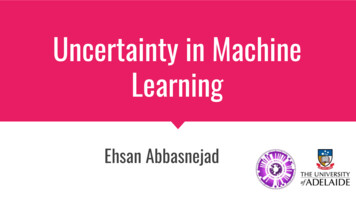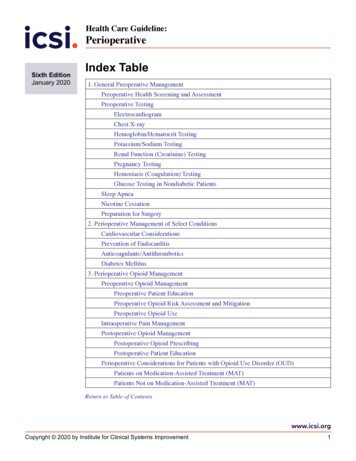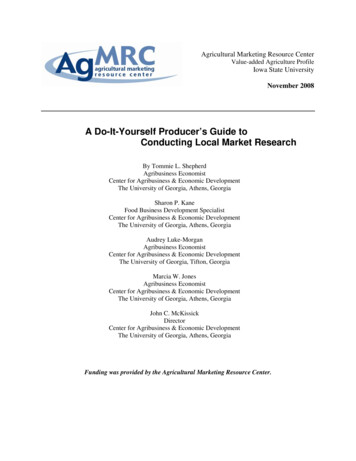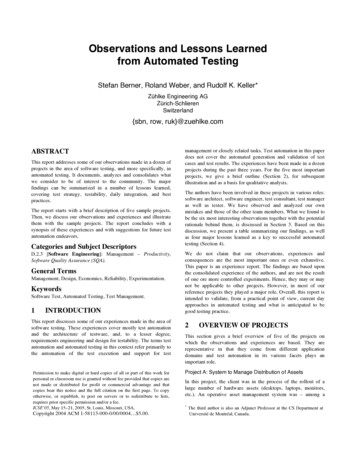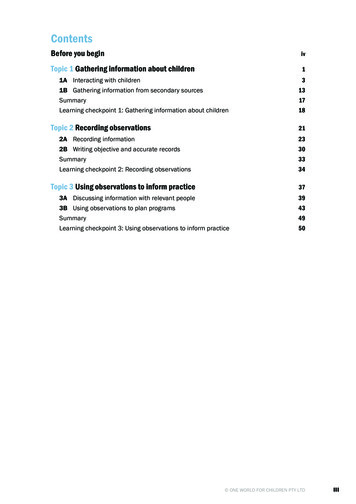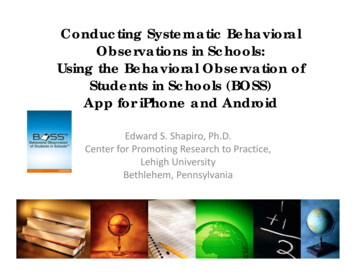
Transcription
Conducting Systematic BehavioralObservations in Schools:Using the Behavioral Observation ofStudents in Schools (BOSS)App for iPhone and AndroidEdward S. Shapiro, Ph.D.Center for Promoting Research to Practice,Lehigh UniversityBethlehem, Pennsylvania
AGENDA Brief Overview of Systematic Observation In Depth Overview of the BehavioralObservation of Students in Schools (BOSS) Using the iPhone and Android APPS for theBOSS Interpretation of BOSS data2
Overview ofSystematic Observation
Important Reasons for ConductingSystematic Observation Quantitative data collection Systematically confirmation (or disconfirmation) ofteacher subjective judgment Determine actual severity of the reported problem Provide a baseline against which to assess thesuccess/failure of instructional intervention Provides feedback to stakeholders (e.g., caregivers,students, teachers, etc.) regarding the types and4levels of problems students are currently having
What Can Be Learned from SystematicObservation for Academic Assessment? Academic engagementOpportunity to learnActive teaching/learningTeacher directed instructionRate of accurate student responseDemonstrate/prompt/practice5
Identifying the Behaviors for Observation Carefully & precisely define behaviors For academics – what matters Levels of academic engagement Type of engagement Type of non-engagement6
Keys to Good Observations Accurately represents the child’s behavior at thetime of the observation & at other times of theday Situation in which behaviors was observedrepresent where the problems tend to occur Always ask teacher whether the behavior seenthat day was typical for the student7
How much observation is needed? It depends Good Rule of Thumb: 3 observations Accurate observations require at least 10-15minutes Optimally observations should be: 20-30 minutes Observations should be repeated over 2-3 days Across different types of academic settings (e.g.,ISW in reading, small-group in math, large-groupin science, etc.)8
Before Observing in the Classroom Contact the teacher to arrange the best time to observe thestudent Familiarize yourself with the daily schedule, routine, &physical layout of the classroom Clear view of student, but not obtrusive Meet briefly with teacher to learn about classroom rules orprocedures that may be in effect during the observation Observer should minimize any interactions with students orthe teacher during the observation period9
Behavioral Observationof Students in Schools(BOSS)
BOSS App Simple and flexible Recording device/Data storage systemTiming deviceCueing deviceData analysis system Some customization possible by user Reports (pdf and csv files) output via email11
Key Features of the BOSS Designed for Pre-K through 12th grade Systematic recording of direct observations of children’sbehavior in the academic environment Observe key behaviors related to academic skill development Subdivide on-task behavior into active and passive categories Subdivide off-task behavior into motor, verbal, & passivecategories Collect local normative comparison data (e.g., peercomparison) for accurate interpretations12
SETTING UP A NEW SESSION(OBSERVATION) iPhone Android13
SETTING UP A NEW SESSION(OBSERVATION) iPhone Android14
Key Information Observer name, Student name, School, Grade Task (Subject) Language Arts, Mathematics, Reading, Writing Option to add user defined task or subject Science? Social Studies? Guided Reading Groups? Cooperative Groups?15
Key Information - Setting ISW:TPsnt – Student Individual Seatwork: Teacher Present ISW:TSmGp Student Individual Seatwork: Teacher working with thegroup SmGP:TPsnt Student small group ( 10): Teacher working with group LgGp:TPsnt Student large group (10 ): Teacher working with largegroup16 Other – User defined
Entering User Defined Field(iPhone illustrated)17
Key Information Duration Interval18
BOSS Observation Codes(Template Default) On-task behavior subdivided: Actively Engaged Time (AET) Passively Engaged Time (PET) Off-task behavior subdivided: Off-Task Motor (OFT-M) Off-Task Verbal (OFT-V) Off-Task Passive (OFT-P) Teacher Directed Instruction (TDI)19
Active Engaged Time (AET) AET is defined as those times when the student is actively attending to theassigned work Examples: WritingReading aloudRaising a hand to answer a teacher’s questionTalking to the teacher about the assigned materialTalk to a peer about the assigned materialLooking up a word in a dictionaryTyping essay on computerAET should not be scored if the student is: Talking about nonacademic materials (OFT-V)Walking to the worksheet bin (OFT-M)Calling out (OFT-V) – Unless it is considered an appropriate response style for theclassroomAimlessly flipping the pages of a book (OFT-M)Any other form of off-task behavior20
Passive Engaged Time (PET) PET is defined as those times when the student is passively attendingto the assigned work At times it may be difficult to determine immediately whether the child ispassively engaged or daydreaming (OFT-P) at the 1st moment of aninterval If it becomes apparent within 3 seconds after the start of the interval thatthe students was OFT-P or PET you can change your response Examples: Listening to a lectureLooking at an academic worksheetReading assigned material silentlyLooking at the blackboard during teacher instructionListening to a peer respond to a questionPET should not be scored if the student is: Aimlessly looking around the classroom (OFT-P) Silently reading unassigned material (OFT-P) Any other form of off-task behavior21
OFF-Task Motor (OFT-M) OFT-M behaviors are defined as any instance of motor activity that is notdirectly associated with an assigned academic task Examples: Engaging in any out-of-seat behavior (defined as buttocks not in contact with seat)Aimlessly flipping the pages of a bookManipulating objects not related to the academic task (e.g., playing with a paper clip,throwing paper, twirling a pencil, & folding paper)Physically touching another student when not related to an academic taskBending or reaching (e.g., picking up a pencil off the floor)Drawing or writing that is not related to an assigned academic activityTurning around in one’s seat, oriented away from the classroom instructionFidgeting in one’s seat (i.e., engaging in repetitive motor movements for at least 3consecutive seconds; student must be off-task for this category to be scored)OFT-M should not be scored if the student is: Passing paper to a student, as instructed by the teacher (AET)Coloring on an assigned worksheet as instructed by the teacher (AET)Laughing at a joke told by another student (OFT-V)Swinging feet while working on assigned material (AET or PET)22
OFF-Task Verbal (OFT-V) OFT-V behaviors are defined as any audible verbalizations that arenot permitted and/or are not related to an assigned academic task Examples: Making any audible sound, such as whistling, humming, forced burping Talking to another student about issues unrelated to an assigned academictask Talking to another student about an assigned academic task when such talk isprohibited by the teacher Making unauthorized comments or remarks Calling out answers to academic problems when the teacher has notspecifically asked for an answer or permitted such behavior OFT-V should not be scored if the student is: Laughing at a joke told by the teacher Talking to another student about the assigned academic work during acooperative learning group (AET) Calling out the answer to a problem when the teacher has permitted suchbehavior during instruction (AET)23
OFF-Task Passive (OFT-P) OFT-P behaviors are defined as those times when a student is passively notattending to an assigned academic activity for a period of at least 3consecutive seconds within an interval Examples: If the interval ends before the 3 consecutive seconds, OFT-P is not scored for thatintervalThe Count starts over – a new 3 consecutive seconds is needed to score OFT-P in thenew intervalStudent is quietly waiting after the completion of an assigned task but is not engaged inan activity authorized by the teacherSitting quietly in an unassigned activityLooking around the roomStarring out the windowPassively listening to other students talk about issues unrelated to the assignedacademic activityOFT-P should not be scored if the student is: Quietly reading an assigned book (PET)Passively listening to other students talk about the assigned work in a cooperativelearning group (PET)24
Teacher-Directed Instruction (TDI) TDI is defined as those times when the teacher is directlyinstructing the class or individuals within the class Provides a sampling of time in which the teacher is activelyengaged in direct instruction of the classroom Examples: Instructing the whole class or group Demonstrating academic material at the board Individually assisting a student with an assigned task TDI should not be scored if the teacher is: Scolding/Reprimanding the class or an individual student formisbehavior Giving instructions for an academic activity Sitting at his/her desk grading papers Speaking to an individual student or the class about nonacademicissues25
Time Sampling 1 observation of each behavior per interval (15 sec is default)Momentary: Codes: AET & PETAt the start/beginning of each intervalObserver determines whether the student is on-taskTouch the appropriate buttonButtons are toggle (on/off switches)Partial interval: Codes: OFT-M, OFT-V, OFT-P, & TDI If any of these behaviors occur at any point during the interval, touch thecorresponding button Exception is OFT-P: need to be OFT-P for 3 consecutive seconds within theinterval before can record it Buttons are toggle (on/off switches) Every 5th Interval Record Behaviors for TDI &Comparison Peer Buttons are toggle (on/off switches)26
Plan for Choosing Comparison Peers Every 5th interval collect information on comparisonpeers Data for peer observations combined to form peercomparison total Selection of peers Before observation decide sequence of peer comparisonobservations Example: Start in the front left of the classroom & observe adifferent peer every 5th interval, moving down the row and thenfrom back to from Clockwise or counterclockwise Important to have an observation plan throughout27before beginning the observation of the target student
BOSS Template Observations iPhone Android28
Peer ObservationiPhoneAndroid29
Customizing the Template BOSS Apps allow user to develop userdefined template Can include any user defined category ofbehavior Can mix BOSS categories with user definedcategory Template is saved for future use30
Setting Up Custom TemplatesiPhoneAndroid31
Setting Up Custom TemplatesiPhoneAndroid32
Setting Up Custom TemplatesiPhoneAndroid33
Setting Up Custom TemplatesiPhoneAndroid34
Conducting the ObservationiPhoneAndroid35
Conducting the ObservationiPhoneAndroid36
When the Observation is CompletediPhoneAndroid37
When the Observation is CompletediPhoneAndroid38
Previous ObservationsiPhoneAndroid39
Sample Observation Focus on target student Homero Target Student sitting to right in orange used as peerobservation40
Reports from the BOSS AppiPhoneAndroid41
Reports Generated Professional report including graphicsoutputs as .pdf file CSV file42
Page 1 Basic Identification InfoCount and Percent of each categoryof behaviorInterval table showing results ofeach interval43
Page 2 Behavior Legend (only evident forDefault BOSS template)Graphic illustrations (in color) ofMomentary and Partial intervalsbehaviorsGraphic comparisons of target andpeers on each behavior44
CSV File Opens an CSV spreadsheet withinMS-ExcelProvides same data as pdfFormat permits manipulation of thedataObserver NEd SStudent :TpsntDuration10:00Interval Le 15 secTarget Stats:AET25.00% PETPeer Stats:AET75.00% PETTeacher Stats:TDI75.00%50.00% OFT‐M25.00% OFT‐V40.62% OFT‐P25.00%25.00% OFT‐M12.50% OFT‐V25.00% 0000111101451
BOSS Interpretation Data obtained during observation DO NOT represent an estimate of theamount of time that a behavior would occur Because observation system is derived from a time-sampling strategy, itwould be inaccurate to say that the behavior occurred for % of the time Report findings as % of the observed intervals Partial-interval recording systems are likely to overestimate the actualrate of a behavior’s occurrence Data collected for target student are more reliable & stable then thedata collected for peer comparison purposes The more observation intervals, the better the stability of the measure46
BOSS Interpretation Meet with teacher after observation: Does observation represent typical classroom behavior? Levels of academic engagement & nonengagement for target student in the particularobservation setting Levels of AET/PET combined vs Levels and types of OFT behavior amount of on/offtask Extent to which target student is effectively engaged in the learning process Comparisons across multiple settings Relative differences in the target student’s academic engagement in different instructionalenvironments Differences between AET/PET suggests opportunity to respond problems Students who are struggling in school are often to have relatively low levels of AET evenwhen they are on-task Compare the performance of target to peers Type of local normative data Degree to which the levels of target’s behavior differed from classroom expectations47
Visual Representation of the Data48
Embed BOSS Data in Reports49
Research Publications with theBOSS Bahr, M., Gouwens, D.A., & Schuh, G. (2012). Evaluation of hand held computers for direct systematic classroomobservation. Computers in the Schools, 29: 268-284.Breisch, A.M., & Daniels, B. (2013). Using self-management interventions to address general education behavioral needs:An assessment of effectiveness and feasibility. Psychology in the Schools, 50, 366-381.DuPaul, G. J., Volpe, R. J., Jitendra, A., Lutz, J. G., Lorah, K., & Gruber, R. (2004). Elementary school students withADHD: predictors of academic achievement. Journal of School Psychology, 42, 285-301.Hosterman, S.J., DuPaul, G. J., & Jitendra, A. (2008). Teacher ratings of ADHD symptoms in ethnic minority students:Bias or behavior differences? School Psychology Quarterly, 23, 418-435.Junod, R. E. V., DuPaul, G. J., Jitendra, A. K., Volpe, R. J., & Cleary, K.S. (2006). Classroom observations of studentswith and without ADHD: Differences across types of engagement. Journal of School Psychology, 44, 87-104.Kraemer, E.E., Davies, S.C., Arndt, K. J., & Hunley, S. (2012). A comparison of the mystery motivator and the “Get ‘EmOn Task” interventions for off-task behaviors. Psychology in the Schools, 49, 163-175.Pfifiner, L.J., Villodas, M., Kaiser, N., Tooney, M., & McBurnett, K. (2013). Educational outcomes of collaborativeschool-home behavioral intervention for ADHD. School Psychology Quarterly, 28, 25-36.Riley, J. L., McKevitt, B. C., Shriver, M. D., & Allen, J. (2011). Increasing on-task behavior using teacher attentiondelivered on a fixed time schedule. Journal of Behavioral Education, 20, 149-162.Steiner, N. J., Sidhu, T., Rene, K., Tomasetti, K., Frenette, E., & Brennan, R. T. (2013). Development and testing of adirect observation code training protocol for elementary aged students with attention deficit/hyperactivity disorder.50Educational Assessment, Evaluation and Accountability, DOI 10.1007/s11092-013-9166-x.
Bottom Line BOSS Provides quantitative index to observing behavior Easy to use, flexible, and meaningful tounderstanding classroom behavior Opportunity to customize beyond BOSS template Relevant and needed for conducting school-basedevaluations Valuable tool linked to best practice in assessment51
Questions?52
Available on iTunes andGoogle PlaySearch “BOSS Education”53
Provides same data as pdf Format permits manipulation of the data Observer NEd S Student NaMilo2 School Upper Grade 3 Task Mathematics Setting LgGp:Tpsnt Duration 10:00 Interval Le15 sec Target Stats: AET 25.00% PET 50.00% OFT‐M 25.00% OFT‐V 40.62% OFT‐P 25.00% Peer Stats: AET 75.00% PET 25.00% OFT‐M 12.50% OFT‐V 25.00% OFT .
